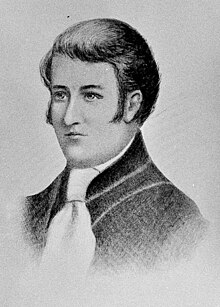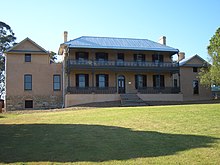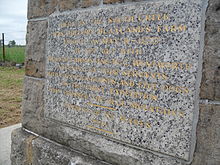| Gregory Blaxland | |
|---|---|
 Portrait, 1813 Portrait, 1813 | |
| Born | (1778-06-17)17 June 1778 Kent, England |
| Died | 1 January 1853(1853-01-01) (aged 74) New South Wales, Australia |
| Burial place | All Saints Parramatta |
| Known for | 1813 crossing of the Blue Mountains |
| Spouse | Elizabeth Spurdon ( - 1826) |
| Children | 7 - John Blaxland |
| Parents |
|
Gregory Blaxland (17 June 1778 – 1 January 1853) was an English pioneer farmer and explorer in Australia, noted especially for initiating and co-leading the first successful crossing of the Blue Mountains by European settlers.
Early life

Gregory Blaxland was born 17 June 1778 at Fordwich, Kent, England, the fourth son of John Blaxland, mayor from 1767 to 1774, whose family had owned estates nearby for generations, and Mary, daughter of Captain Parker, R.N. Gregory attended The King's School, Canterbury. In July 1799 in the church of St George the Martyr there, he married 20-year-old Elizabeth, daughter of John Spurdon; they had five sons and two daughters.
The Blaxlands were friends of Sir Joseph Banks who appears to have strongly influenced the decision of Gregory and his eldest brother, John, to emigrate to Australia. The government promised them land, convict servants and free passages, in accord with its policy of encouraging 'settlers of responsibility and capital'. Leaving John to sell their Kent estates, Gregory sailed in the William Pitt on 1 September 1805 with his wife, the three children they then had, two servants, an overseer, a few sheep, seed, bees, tools, groceries and clothing.
Blaxland and his family reached Sydney on 1 April 1806, where he sold many of the goods he brought with him very profitably, bought eighty head of cattle so as to enter the meat trade, located 2,000 acres (810 ha) of land at St Marys and was promised forty convict servants. Soon afterwards he also bought 450 acres (180 ha) at the Brush Farm (near Eastwood) from D'Arcy Wentworth for £1500, while also displaying some of his future characteristics by commencing litigation against the master of the William Pitt. A further parcel of 2,280 acres (920 ha) was granted for a farm at the South Creek.
Blue Mountains expedition
Main article: 1813 crossing of the Blue Mountains
Early in 1813 Blaxland, who needed more grazing land, obtained the approval of Governor Lachlan Macquarie for an attempt to cross the Great Dividing Range, known as the Blue Mountains, following the mountain ridges, instead of following the rivers and valleys. He secured the participation of William Lawson and William Charles Wentworth in the expedition, which was successful (though the expedition stopped short of actually crossing over the mountains) and enabled the settlers to access and use the land west of the mountains for farming. The crossing took 21 days, and only 6 days to return.
In February 1823 Blaxland published his Journal of a Tour of Discovery Across the Blue Mountains (London, 1823) in which he wrote:
- "On Tuesday, May 11, 1813, Mr. Gregory Blaxland, Mr. William Wentworth, and Lieutenant Lawson, attended by four servants, with five dogs, and four horses laden with provisions, ammunition, and other necessaries, left Mr. Blaxland's farm at the South Creek, for the purpose of endeavouring to effect a passage over the Blue Mountains ..."
In recognition of the successful crossing, all three explorers were granted by Macquarie 1,000 acres (400 ha) of land west of the mountains.
Other activities
Blaxland is also noted as one of the first settlers to plant grapes for wine-making purposes. He was engaged during the next few years in wine-making. He had brought vines from the Cape of Good Hope and found a species resistant to blight.
Blaxland's diaries show that he had a clear grasp of the scale upon which agricultural and pastoral activities would be profitable in Australia. In 1814, like many others almost insolvent because of drought and depression, he tried to persuade Governor Macquarie to sanction a scheme for the exploitation of the interior by a large agricultural company similar to the later Australian Agricultural Company of the 1820s. Macquarie would not agree nor would he allow Blaxland land in the interior for his own flocks. Blaxland then had to dispose of his livestock, and joined the colonial opposition to Macquarie, and in 1819 sharply criticised his administration to Commissioner John Thomas Bigge.
Blaxland visited England in 1822 taking with him a sample of his wine. While in England he published in February 1823 his Journal of a Tour of Discovery Across the Blue Mountains. Later the same year, Blaxland was awarded the silver medal of the Royal Society of Arts for the wine he had brought to London.
Later years
His wife died in December 1826. In January 1827 Blaxland was elected by a public meeting with two others to present a petition to Governor Darling asking that "Trial by jury" and "Taxation by Representation" should be extended to the colony. Still opposed to the governor's authority, he made another visit to England, taking a petition in support of trial by jury and some form of representative government, and again carried samples of his wine, for which he won a gold medal of the Royal Society of Arts in 1828.
He successfully petitioned the Colonial Office for a drawback on the import duty on brandy imported into the colony and 'actually used in the manufacture of wine'. Always a man of moody and mercurial character, Blaxland devoted his colonial activities almost entirely to the pursuit of his agricultural and viticultural interests.
He suffered great personal loss with the early and untimely deaths of his second son, youngest son and wife along with others quite close to him in rapid succession, which bore very heavily on his heart. He committed suicide on 1 January 1853 in New South Wales and was buried in All Saints Cemetery in Parramatta.
His son John was a prominent businessman. He was appointed to the New South Wales Legislative Council and served there from 1863 until his death in 1884.
Publications
- A Journal of a Tour of Discovery Across the Blue Mountains, 1823
- Wine from New South Wales, 1828
Recognition

- The township of Blaxland in the Blue Mountains is named after him, as is the Australian Electoral Division of Blaxland.
- Blaxland Creek runs near his land grant in western Sydney.
- Gregory, Blaxland, Lawson and Wentworth Avenues are found in the Melbourne suburb of Frankston where the Blaxland Avenue Reserve runs through.
- Blaxland Road
- Eastwood
- Wentworth Falls
In 1963 he was honoured, together with Lawson and Wentworth, on a postage stamp issued by Australia Post depicting the Blue Mountains crossing.
See also
References
- ^ Conway, Jill (1966). "Blaxland, Gregory (1778–1853)". Australian Dictionary of Biography. Canberra: National Centre of Biography, Australian National University. pp. 115–117. ISBN 978-0-522-84459-7. ISSN 1833-7538. OCLC 70677943. Retrieved 27 July 2022.
- "History since colonisation". Blue Mountains National Park. NSW Parks and Wildlife Service. Retrieved 27 May 2013.
- Clark, Manning (1962), A history of Australia (1 ed.), Melbourne University Press; London; New York : Cambridge University Press, p. 277, ISBN 978-0-522-84008-7
- ^ "The Journal of Gregory Blaxland". State Library of NSW. – digitised copy
"The Journal of Gregory Blaxland". gutenberg.net.au. – html text - Dunlop, E. W. (1967). "William Lawson". Australian Dictionary of Biography. Canberra: National Centre of Biography, Australian National University. ISBN 978-0-522-84459-7. ISSN 1833-7538. OCLC 70677943. Retrieved 27 July 2022.
- Boardman, Alan; Harvey, Roland (1997), The crossing of the Blue Mountains, Scholastic, pp. 29–30, ISBN 978-1-86388-707-6
- "Family Notices". Sydney Gazette and New South Wales Advertiser. 30 December 1826. p. 2 – via Trove.
- "No. I. Wine from New South Wales". Transactions of the Society, Instituted at London, for the Encouragement of Arts, Manufactures, and Commerce. 1 January 1827.
- "Gregory Blaxland". Blaxland Wine Group. 2 April 2014. Archived from the original on 23 October 2019. Retrieved 12 June 2017.
- "Parramatta". The Sydney Morning Herald. 4 January 1853. p. 2 – via Trove.
- "Sydney News". The Maitland Mercury and Hunter River General Advertiser. 8 January 1853. p. 4 – via Trove.
- "Family Notices". Colonial Times. 20 January 1853. p. 2 – via Trove.
- Google Maps display of Frankston Reservoir
- "Image: 0007540.jpg, (378 × 264 px)". Australian Stamp and Coin Company. Retrieved 2 September 2015.
External links
- Serle, Percival (1949). "Blaxland, Gregory". Dictionary of Australian Biography. Sydney: Angus & Robertson.
- A journal of a tour of discovery across the Blue Mountains in New South Wales, Gregory Blaxland, online copy, State Library of New South Wales DSM/981.5/6D1